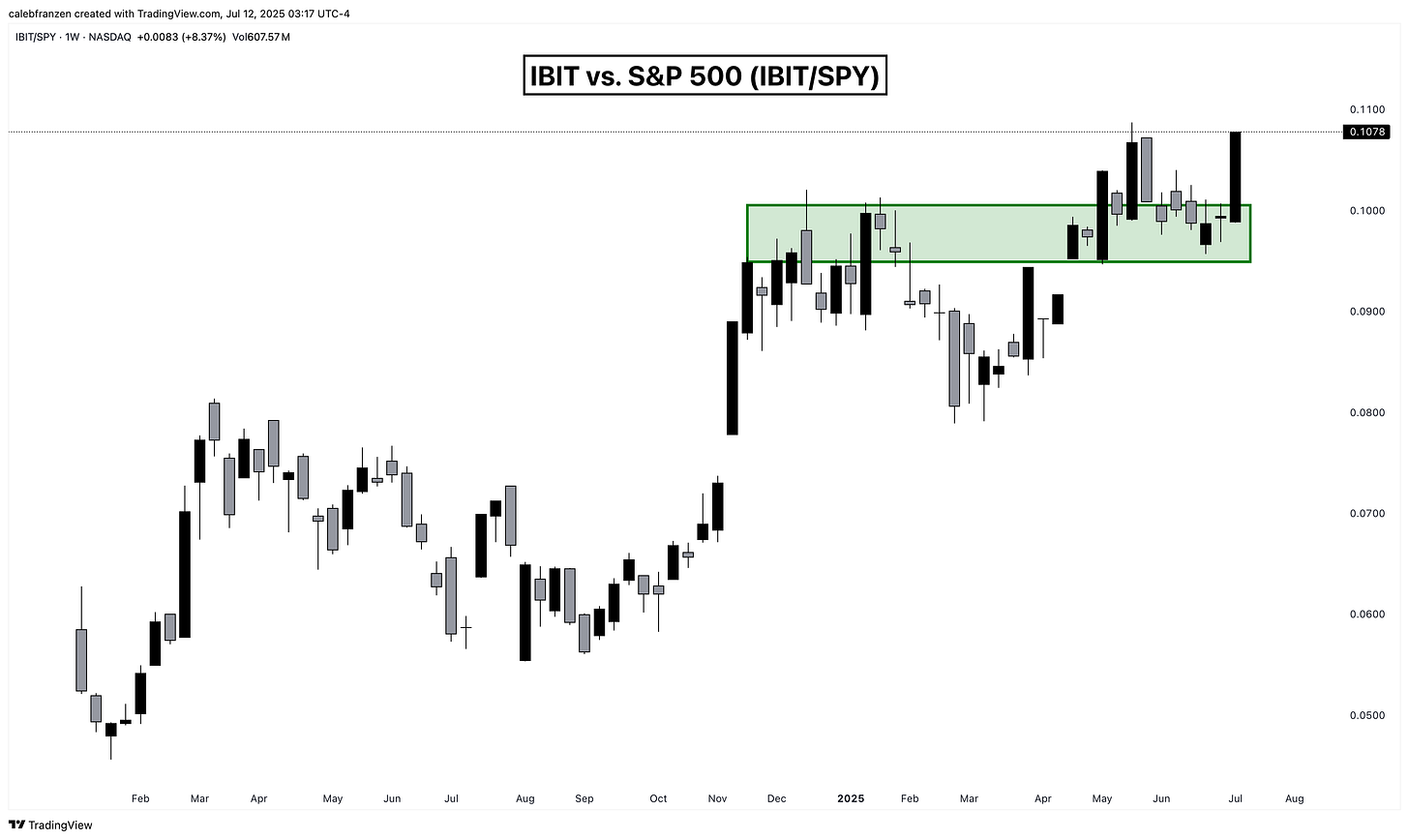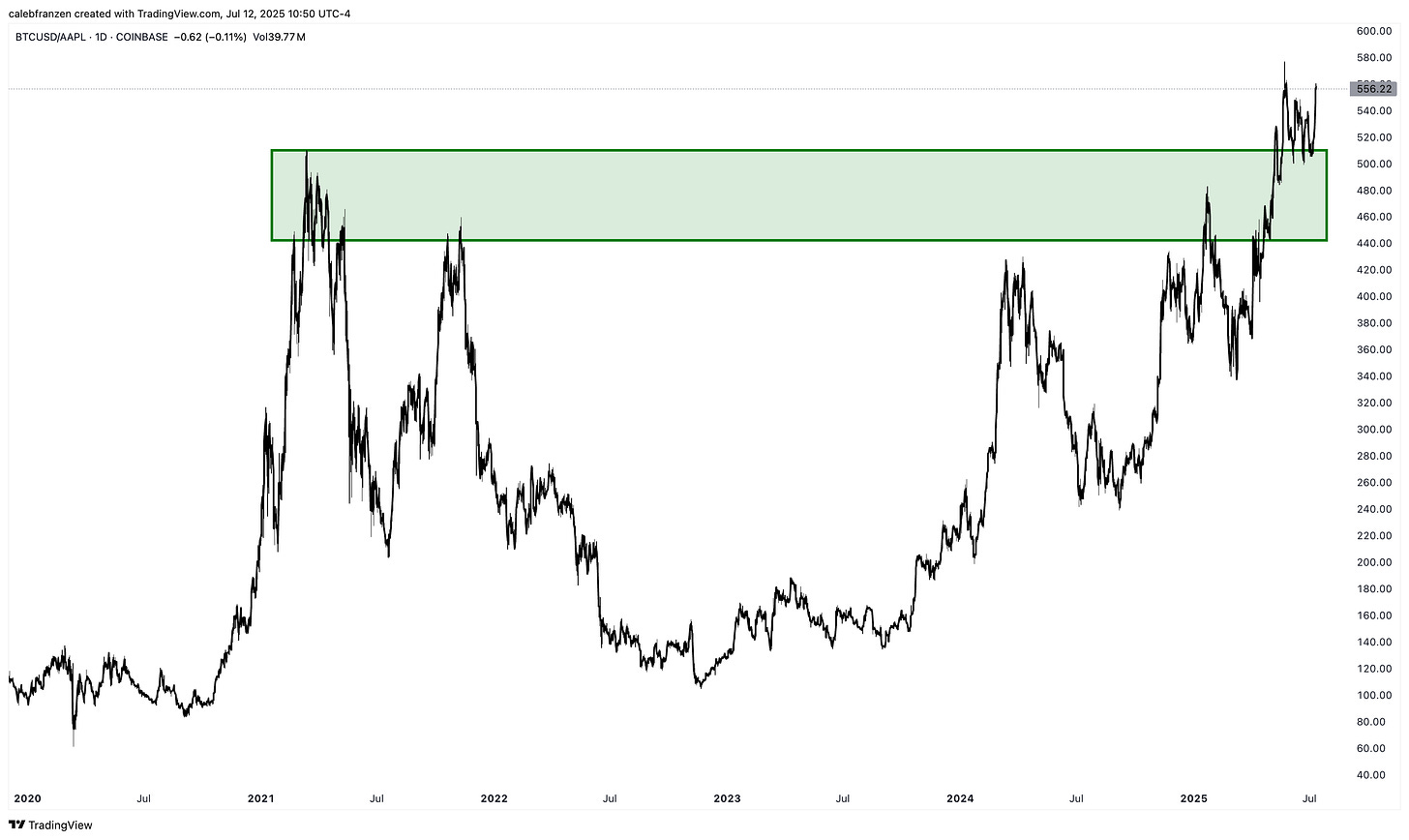Investors,
Bitcoin just had its highest weekly close ever relative to the S&P 500.
You’re all familiar with opportunity cost — the “cost” of not doing something.
We constantly face opportunity costs as investors because we have limited capital.
For every $10,000 that I invest in GOOGL, it’s $10,000 that I can’t invest in META.
This is what makes relative performance (Asset X / Asset Y) so important, because it allows us to evaluate opportunity cost, or the lack thereof. As investors focused on generating returns, it’s vital to ensure that we are doing our best to capitalize on market conditions, which inherently means that we should seek to reduce opportunity cost in order to maximize returns.
So when Bitcoin is making new all-time highs (on a weekly closing basis) relative to the S&P 500, there’s only one conclusion: Bitcoin investors don’t have an opportunity cost vs. the S&P 500 because they have never been better off. On the contrary, traditional stock investors are the ones with the opportunity cost because they would’ve been better off owning Bitcoin instead of equities, on the aggregate.
I’ve been following Bitcoin for nearly a decade now, first as a staunch critic and then as a staunch proponent, and I can tell you that Bitcoin is evolving before our very eyes.
Actually, I take that back — Bitcoin isn’t evolving… investors are evolving.
What used to be dismissed as a Ponzi scheme, a bubble, and a scam (particularly by legacy financial pundits & investors), is now being embraced by those same investors.
The fundamental story is stronger than ever: a permissionless monetary network with a decentralized and global security infrastructure, used to send and store one of the scarcest assets on the plant without an intermediary.
Whether you agree with this fundamental narrative or not, price doesn’t lie.
Bitcoin’s market cap is $2.34Tn, enough to be the world’s 6th largest individual asset.
On Thursday alone, the price of one Bitcoin increased by $4,600 (or +4.2%).
On March 16th, 2020, just 5.3 years ago, one entire Bitcoin was worth $4,600.
By definition, that can only happen with increased demand (aka adoption) and more global investors recognizing the value of digital scarcity.
So as we think about opportunity cost within this ongoing bull market, we must recognize, objectively, that Bitcoin carries one of the lowest opportunity costs because it produces some of the strongest returns across the entire market.
And not just any returns… risk-adjusted returns!
I wrote a post on X explaining the math to prove it.
If we make the assumption that the uptrend in asset prices will remain intact and that risk appetite will stay around these elevated levels (or even increase), then the conclusion is that Bitcoin is likely to gain even more traction against the larger assets in the chart above.
It’s already encroach on Amazon, but this is BTC/AMZN chart to give an indication:
I see a steady production of higher highs & higher lows for the past 3 years.
What about Bitcoin relative to Apple (BTC/AAPL)?
It’s flipping the prior cycle highs into support after a recent breakout to new ATHs.
That’s a “breakout, retest, rebound” setup, which is common during uptrends.
What about Bitcoin relative to Microsoft (BTC/MSFT)?
This hasn’t even made new all-time highs yet, which could foreshadow an explosive move in the weeks/months ahead if this is able to achieve a breakout.
The only major asset that has performed better than Bitcoin is Nvidia — the world’s most important and largest company, which just crossed above a $4Tn valuation.
But despite NVDA’s historic run, Bitcoin has actually BTC matched the stock’s performance over the past 2 years, given that the BTC/NVDA chart is trading at the exact same level that it was in July 2023.
In other words, while NVDA has become the most important company in the world, Bitcoin has matched its performance.
That’s nothing to scoff at.
So as an investor, you have some choices…
Do you want to align with the uptrend in risk assets, or do you want to fight it?
If you want to align with the uptrend, what is the best way to exercise that thesis?
In other words, how can you generate the best returns with the least amount of risk and reduce your opportunity cost?
In my opinion, based on the conclusions of the charts that we’ve discussed in this report, I think it’s unequivocal that a non-zero amount of Bitcoin exposure will help to generate risk-adjusted outperformance.
But hey, I’ve put my money where my mouth is — I have over 70% of my net worth invested in Bitcoin and I’ve been able to enjoy the fruits of my convictions.
You do you.
Best,
Caleb Franzen,
Founder of Cubic Analytics
This was a free edition of Cubic Analytics, a publication that I write independently and send out to ~14,000 investors every Saturday. Feel free to share this post!
To support my work as an independent analyst and access even more exclusive & in-depth research on the markets, consider upgrading to a premium membership with either a monthly or annual plan using the link below:
There are currently 1,070+ investors who are on a premium plan, accessing the exclusive alpha and benefits that I share with them regarding the stock market, Bitcoin, and my own personal portfolio.
DISCLAIMER:
This report expresses the views of the author as of the date it was published, and are subject to change without notice. The author believes that the information, data, and charts contained within this report are accurate, but cannot guarantee the accuracy of such information.
The investment thesis, security analysis, risk appetite, and time frames expressed above are strictly those of the author and are not intended to be interpreted as financial advice. As such, market views covered in this publication are not to be considered investment advice and should be regarded as information only. The mention, discussion, and/or analysis of individual securities is not a solicitation or recommendation to buy, sell, or hold said security.
Each investor is responsible to conduct their own due diligence and to understand the risks associated with any information that is reviewed. The information contained herein does not constitute and shouldn’t be construed as a solicitation of advisory services. Consult a registered financial advisor and/or certified financial planner before making any investment decisions.
Each investor is responsible to understand the investment risks of the market & individual securities, which is subjective and will also vary in terms of magnitude and duration.










